Thanks to their popularity and brilliant colors koi are instantly recognizable by people all over the world. Koi care may seem complex, given the beauty of the ponds and aquascaping involved. But they have basic requirements that any well-educated pond keeper can provide. And this handy koi fish care guide will arm you with just the right knowledge you need to enjoy your fish for decades to come!
Koi Fish Care Overview
So what are koi, exactly? Koi are an ornamental variety of the Amur Carp (Cyprinus rubrofuscus), an Asian cyprinid closely related to goldfish, barbs, and danios. Koi were originally bred in Japan in the 19th century as an answer to the Chinese tradition of keeping ornamental goldfish (Carassius auratus). The term “koi” is an anglicized shortening of their full name: “nishikigoi” (錦鯉) in Japanese!
Before they were raised for color, nishikigoi were actually kept mostly as food fish since they breed readily in ponds and are hardy enough to overwinter in the chilliest regions of the country. But eventually, people started isolating variants that showed colors that differed from the muddy brown wild-type carp.
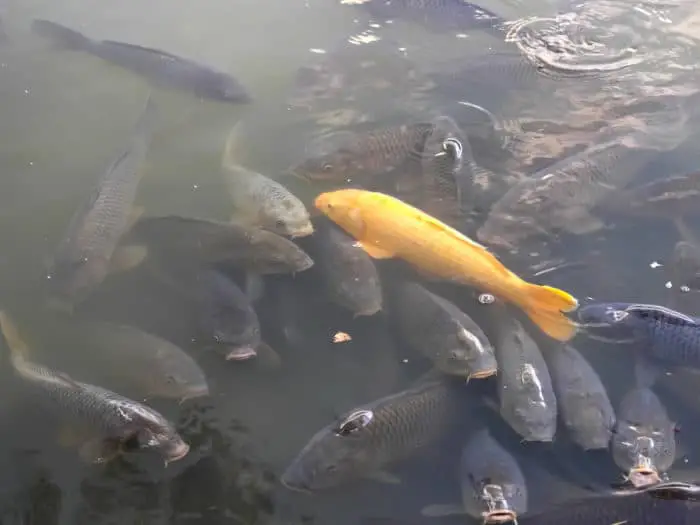
Koi now come in hundreds of varieties standardized and recognized by both Japanese and international organizations that classify them based on color, pattern, and scale type. But all of them are hardy temperature water fish that can be kept in both outdoor ponds and indoor aquariums!
The main requirements koi have are a need for space and clean water. Koi are resistant to elevated levels of ammonia, nitrite, and nitrate but should never be kept continually in these conditions. Fortunately, a good quality canister filter or pond filter paired with live plants ensures you can provide conditions close to 0 ppm, which all fish prefer! But how about living quarters? Which do koi prefer, ponds or aquariums?
Koi Fish Ponds & Aquariums
The habitat you choose to place your koi in is one of the most important things to take into consideration. There is of course the ubiquitous koi pond but an aquarium or tank is an option in some circumstances as well. Each of these options has its own pros and cons.
Keeping Koi in Home Aquariums
So why keep koi in a home aquarium versus a pond? The main reasons are the ease and speed of setting up an aquarium and the lower cost. Outdoor ponds cost more, require more planning, and take up much more space compared to a home aquarium. Or, an outdoor pond may simply not be an option where you live.
That said, koi really are good for aquariums only when they are young. A full-grown koi can be nearly 3 feet long, meaning you’ll definitely be moving them to an indoor or outdoor pond at some point. But they take many years to outgrow aquariums, allowing you to keep them in a more convenient home for a long time.
Keeping koi indoors also means that you don’t have to deal with overwintering them, which involves extra technology and feeding them wheat germ-based winter food as the days grow shorter. You can enjoy your koi all year-round instead of from mid-spring through fall.
The only real disadvantage is that you simply have to transition to a pond or rehome your koi at some point. So you’re really delaying the inevitable when keeping koi in an aquarium.
Keeping Koi in Outdoor Ponds
As a koi keeper, you also have the option of keeping your carp in an outdoor pond all year round, even if you’re from colder parts of the world. Koi are from Japan, which is a temperate country with hard winters where ponds freeze over. Koi have the ability to hibernate during the winter, slowing their metabolic processes enough that they don’t need to eat for months and their oxygen usage is minimal.
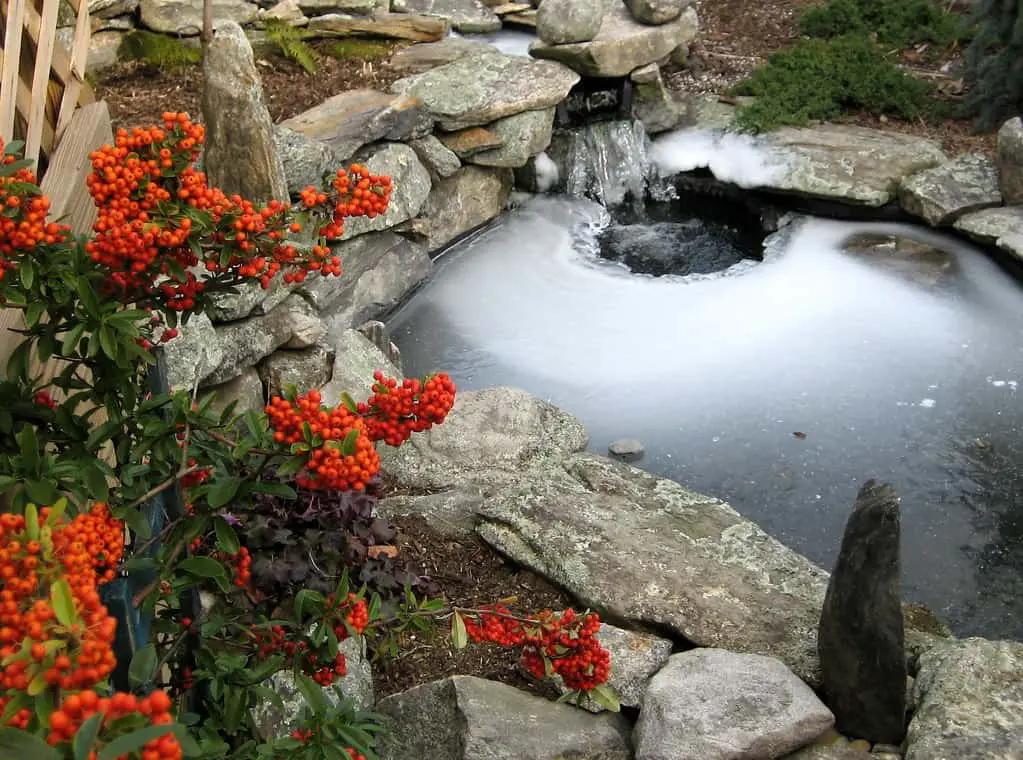
This does require having a pond de-icer on hand to keep a hole open in the ice for proper gas exchange. But so long as you follow the protocol you will find your koi hungry and active once the ice thaws and spring arrives. Koi also provide a fantastic outdoor focal point for your landscaping. Coupled with waterfalls, statues, and other additions, it’s hard to beat a koi pond when looking for artistry and a place to relax!
Lastly, koi will never outgrow an appropriately sized outdoor pond. When I say “appropriately sized,” I mean a pond that’s both deep enough for them to overwinter and long enough for them to live comfortably as adults. 3 feet is a good minimum depth for a koi pond, with 4 feet being better in regions where the pond is guaranteed to ice over. Since koi prefer temperate conditions they don’t enjoy being kept in shallow water in areas that have hot summers. The sun can heat shallow ponds to dangerously high temperatures and lower the dissolved oxygen content enough to leave your fish gasping near the surface. Otherwise, you’ll see your koi spending most of their time in the cooler, well-oxygenated, deeper portions of a pond until it’s time to eat!
The main downside of keeping koi in outdoor ponds is the planning and expense involved. Ponds simply take more time and effort to set up. Of course, once it’s finished you’ll have a water feature like no other that will last you for decades to come. But an aquarium is faster and easier on the wallet. Just remember that your koi will still outgrow any aquarium at some point.
Koi and Outdoor Predators
Ground Predators
Another potential downside of keeping koi outdoors is that they are at constant risk from neighborhood predators. Free-roaming cats, raccoons, and minks may be regular visitors to your pond once they realize that it’s full of fat fish that can’t escape. While they are very common in urban and suburban regions in the USA they are also the easiest of predators to deal with.
Both cats and raccoons require a perch to access your fish. Raccoons in particular are waders but not swimmers. A pond with a shallow shelf is exactly what they like since they can then walk around the edges, hoping to catch a koi. But a pond with a deep shelf will prevent them from reaching your fish.
Other ground predators like minks can swim and may need a more effective deterrent like an electric fence. This doesn’t need to be a tall fence like those seen in a horse pasture. Instead, they can be just a few wires less than a foot off the ground.
Flying Predators
Herons, egrets, and other predatory birds are a bigger problem for outdoor ponds because they have long legs that let them stand unhindered in a few feet of water. They can fly so it’s hard to keep them out of your yard. And they tend to hunt at the break of dawn or at dusk because the light levels are low and they have a chance to pick fish off before they become easily visible.
These hours are also when you’re least likely to be out, enjoying your pond. If you don’t have a shelf where raccoons can hunt yet you find fish continually vanishing it’s likely you’re being visited by a hungry heron for breakfast or a late dinner.
There are two main strategies for dealing with herons and egrets. The first is to cover your pond with mesh netting when you aren’t around. This way the birds simply can’t get to any of your fish or land in the pond. The downside of this approach is that it doesn’t look good but it’s absolutely fool-proof.
The second is to use a plastic decoy to fool the birds into thinking the pond is occupied already! Owls and hawks are dangerous predators to most birds and placing an owl decoy nearby can often encourage a heron surveying the area to move along. Herons and egrets are also quite territorial; a decoy heron or egret placed in the pond often has the same effect. Lastly, you can use a floating alligator decoy, which frightens the birds off! Just remember to move the decoys every few days, otherwise, the birds tend to wise up and ignore them.
Fully grown koi are too large for even the most determined heron or egret to swallow. But they may try snatching one anyway – and their spear-like beaks can leave ragged wounds that never properly heal. So be vigilant when it comes to outdoor koi predators!
How Many Gallons Per Koi?
Once you have decided on a koi pond or koi aquarium you need to determine how large it needs to be.
So how many gallons do we need per koi? On the surface, this seems like a simple question but in reality, it is more complicated than this. There are a variety of factors that come into play such as pond design, water flow rate, oxygen levels, filtration system, aquatic plants, and frequency of water changes.
There are a couple of rules of thumb that are a good place to begin. The first is 1 inch of fish per 10 gallons of water. For instance, if you have a 16-inch koi you would need 160 gallons of water. This is a cumulative guideline for total number of inches of fish in the water. So if you had 4 16 inch fish you would need to multiply 4 x 16 to get 64 inches which would require 640 gallons of water.
Keep in mind that this is a minimum and more water is generally better. It’s also important to mention that koi grow rapidly. So those 6-inch koi you bought will soon be 12 inches, and then 24 inches! Keep this growth potential in mind when determining water volume needs.
Another more generous rule of thumb is 1 fish per 250 gallons or 4 fish per 1000 gallons. This takes into account the growth potential of a koi to reach 24 inches.
Filtration and Water Quality
Water Filtration
In order to keep your fish healthy for years to come, you’ll need more than space, though. You’ll need to be able to test and maintain good water conditions for your koi. Fortunately, it’s easier than ever to ensure that ammonia, nitrite, and nitrates, the three major pollutants in aquatic ecosystems, are well controlled!
Nearly all pond designs rely on a filter of some kind. And the majority of pond filters use a plastic or metal box attached to the edge of the pond or submerged underwater. A pump then forces water into the filtration unit and through a series of physical and chemical media, before returning the treated water back to the pond.

A mature filter enables you to process the nitrogenous wastes that fish release. And the biological filtration component is especially important. Biological filtration involves partnering up with beneficial bacteria that actually feed on ammonia, reducing it to nitrite, which is less toxic but still not very good for fish.
Fortunately, a second set of bacteria eats nitrite, converting it into nitrate, which is even less toxic. While these bacteria are found throughout the water column and substrate a proper filter gives them a place to breed. Pond plants are also useful partners for your biological filtration system since they consume all three of these chemicals as fertilizer.
Testing Water Quality
Monitoring your water quality is also important because sudden shifts can be deadly for your fish. Water test kits allow you to test the pH, ammonia, nitrate, hardness levels, and other parameters to ensure they stay within a livable range. Fortunately, koi are quite undemanding when it comes to pH, preferring a range that’s slightly acidic to moderately alkaline (pH 6.5-8.0). They are also unconcerned with hardness levels (dissolved minerals) so long as they avoid extremes.
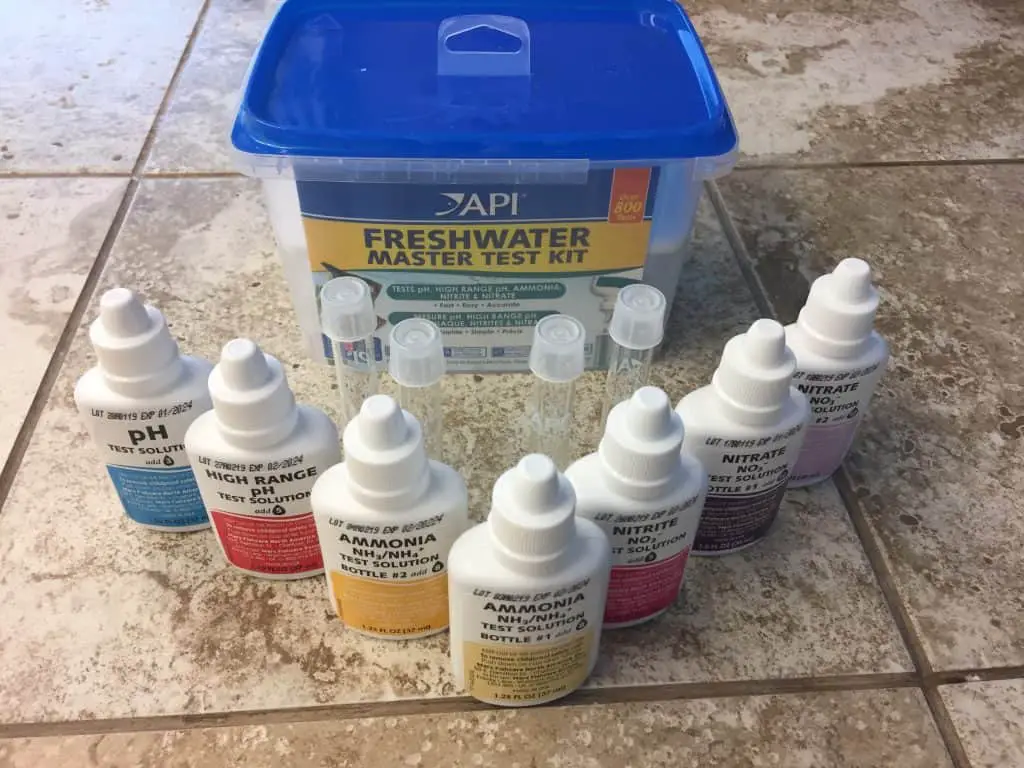
Ammonia and other nitrogenous wastes should be your first priority and then the temperature of your aquarium or pond, making a thermometer an important tool to have on hand. Koi thrive in a broad range of temperatures but warm summer temperatures above 75℉ are actively stressful for them if they can’t escape to cooler, deeper portions of a pond.
Koi Fish Health
Diagnosing Stress and Diseases
Prevention is always the best medicine when it comes to keeping any pet healthy. But sometimes things happen and you end up needing to identify and treat an illness. What are some common koi diseases to look out for?
Gasping at the Surface
Koi gasping at the surface is a sign of low dissolved oxygen content; the water at the surface has the most oxygen so your fish are staying there, trying to breathe. The causes are pretty diverse; the most common is poor circulation in your pond or aquarium, which means you should purchase an aeration stone or powerhead.
Warm temperatures can also be an issue because the warmer water becomes the less dissolved oxygen it can hold. High nitrates are another possibility; nitrate can accumulate in the blood of fish, interfering with its ability to exchange CO2 for oxygen and turning their gills brown on close inspection. This is a sign that you’re overdue for a water change or your filter isn’t working properly.
Cloudy Eyes or Excess Mucus
Cloudiness in the eyes or excess mucus are classic signs of a bacterial infection in the eyes or skin. Broad-spectrum antibiotics like Melafix should be used, following instructions to the letter. Excess mucus coupled with shimmying motions or scraping up against rocks and other decorations can also indicate parasites or irritating chemicals in the water.
Abrasions or Lesions
Wounds should be treated very seriously; if you can, moving a koi with an open wound to a hospital tank or small pond for observation is best. Rips along their flanks are most likely the work of a predator like a heron that tried but failed to catch your fish.
Red, inflamed sores are almost always the result of a bacterial or fungal infection that needs treatment. You should also test your water for high levels of ammonia, nitrite, and nitrates since these chemicals depress the immune system and make koi more vulnerable to infections.
Loss of Appetite
If you see one or more koi not being interested in food, you should first consider the time of year. The colder temperatures of early spring and late fall slows their metabolisms enough that they may simply not be hungry! But if you’re not getting close to hibernation then it’s possible they may have internal parasites, especially if you see a dramatic weight loss. Intestinal worms are a constant risk for outdoor pets; fortunately, they are also quite easy to treat with medications like Prazipro.
Koi Nutrition & Feeding
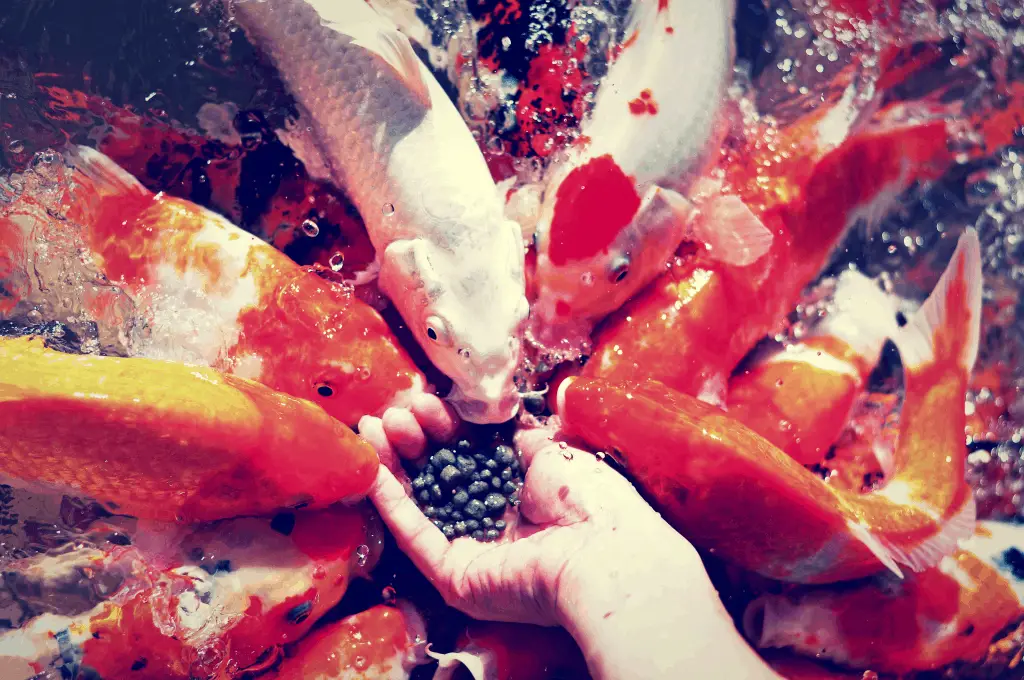
Feeding your koi is one of the great pleasures of keeping these fish! The energy they display as they jostle for pellets and splash about really is a thrill! So let’s talk about koi feeding habits and what sort of food to offer them.
Koi are naturally omnivorous. This means that they eat both plant and animal matter. Algae, soft aquatic plants like Cabomba and Elodea, worms, small snails, and anything else they come across are all quickly eaten. So we want to provide them with as diverse a diet as possible, which promotes good health and spawning behavior once fully grown.
I always recommend taking the time to read the ingredients label when shopping for koi food. Animal proteins like shrimp meal or insect larvae are a great foundation as are plant additives like spirulina. Most koi formulas use wheat germ, potato starch, and other plant-based agents as a base, which is fine so long as the nutritional profile is balanced with other additives. Vitamin and amino acid boosters are also excellent, as are flavor enhancers like garlic or rosemary oil (perfect for picky or sick fish that are unwilling to feed)!
Color enhancers like beta-carotene, astaxanthin, and canthaxanthin are also great additives to be looking out for. These are naturally occurring pigments found in krill and other brightly colored foods. They can accumulate in your koi when eaten, enhancing their red, orange, and yellow tones!
Don’t forget to change blends as you get into late fall and winter approaches. Since their metabolisms slow down as the water temperature falls, they will need more easily digested formulas, which are typically made mostly of wheat germ. The complexity of standard koi food during this period causes it to sit in the digestive tract too long. It can even rot there, leading to intestinal bloat and eventual death.
Koi Fish Companions
As large as they are, koi are surprisingly peaceful, sociable fish that ignore the majority of their tank and pond mates. Larger fish are ideal companions since small fish are likely to be intimidated by a shoal of massive koi. And fish that thrive in temperate regions are best, meaning most tropical aquarium fish are out of the picture. Fortunately, that still leaves quite a few possibilities!
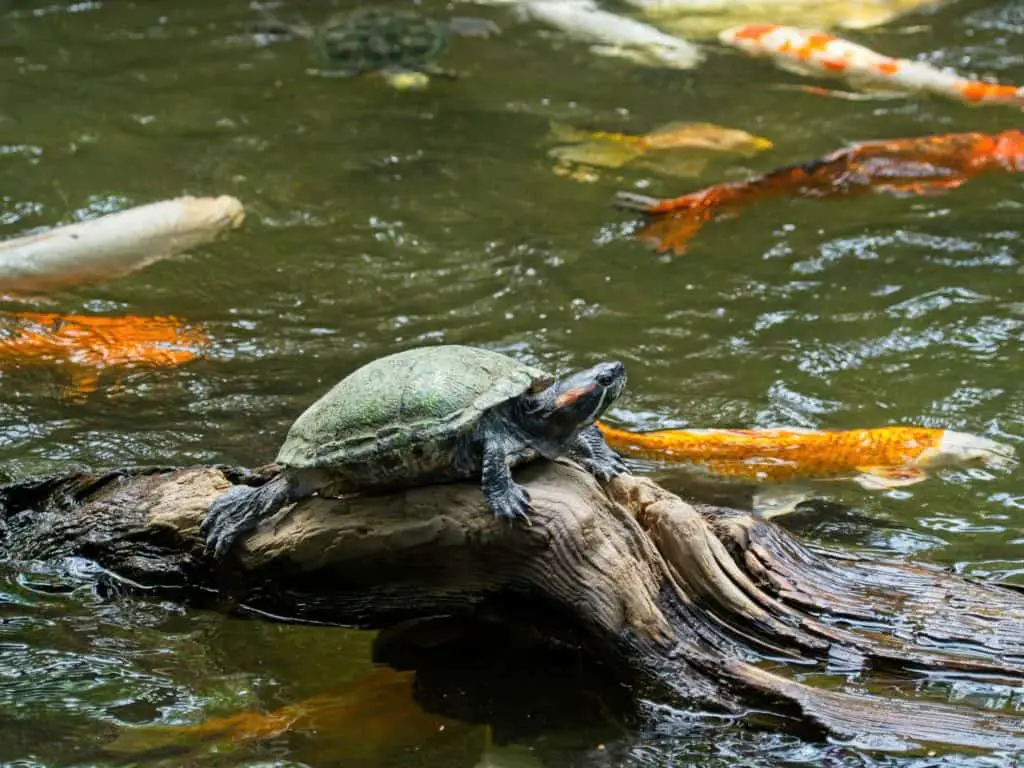
Goldfish & Other Cyprinids
Goldfish and koi are a natural pairing. While smaller, Goldfish come in several color varieties koi don’t, such as the calico shubunkin, adding extra color and contrast to your setup. And they eat precisely the same foods as adult koi, meaning they require no special care. They will even school alongside koi with no reservations!
Other cyprinids aren’t nearly as common but one to look out for is the Chinese Hi Fin Banded Shark (Myxocyprinus asiaticus). This distant relative is found exclusively in the Yangtze River in Central China. When young they have an appealing chocolate and pink banded pattern, coupled with a hunched back and shark-like dorsal fin. As they age, they become rather bland-looking fish – and at 4 feet long, they grow even larger than koi! Fortunately, they are peaceful algae eaters that will eat the same pellets that koi do to supplement their diet!
Another is the Common Tench (Tinca tinca), an Asiatic cyprinid with identical feeding and care requirements as koi. Tench also come in an attractive gold morph that occasionally shows up in aquarium and pond stores. Tench grow to a much more manageable 2 feet in length as adults and are peaceful bottom dwellers.
Apple Snails
Most snails are going to end up as a tasty treat for koi. Koi have pharyngeal (throat) teeth that they use to crunch snail shells with after they’ve swallowed them. You might try some of the largest types; fully grown apple snails are too large for any but the largest of fish to eat. But most other snails will definitely be lunch.
You can use this to your advantage, however, especially with fast-breeding types like ramshorn snails. Your koi will likely never be able to eat them all. And snails eat detritus, algae, and other biofilms and waste that accumulates on the bottom, helping to clean your aquarium or pond!
Turtles
Turtles are popular pond residents but you should be very cautious when keeping them alongside any sort of fish. For starters, they are very opportunistic and are willing to snap at just about anything if they think they can eat it. Even a large koi may find a chunk of tail missing if a turtle gets too close. The best way to deal with this is to keep your turtle constantly well-fed with a mixture of pellets and strips of meat or worms for protein.
Turtles are also extremely messy, creating loose feces that are rich in ammonia. They put a substantial load on your filtration and make frequent water changes mandatory. But if you’re willing to deal with the water quality and predatory issues they make great additions to an outdoor pond.
Just make certain that they have access to a log, rock, or another place in direct sun to bask during the early morning and afternoon. Turtles should also have a second, shadier place to get out of the water while not being directly heated by the sun.
Conclusion
As you can see there, koi fish care is an in-depth but easily understood topic once you’ve taken care of the basics! Koi are just like any other fish, requiring clean water and good food to thrive and grow. They do need a bit more space and prefer cooler temperatures. But if you’re looking to set up a large aquarium or outdoor pond there are few better choices than koi!
